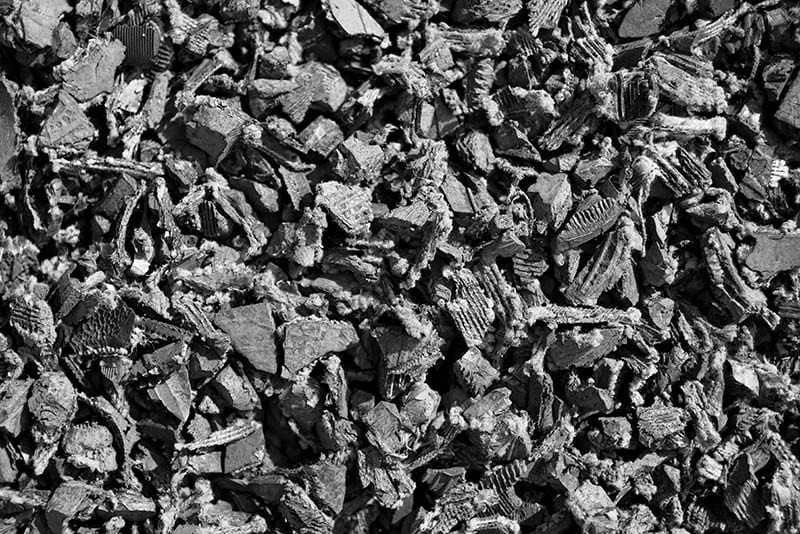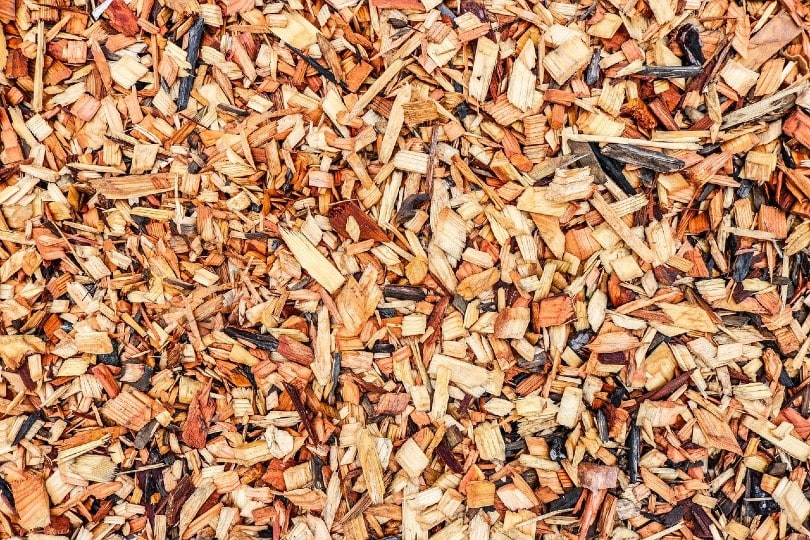Rubber Mulch vs. Wood Mulch: Differences, Pros & Cons
-
Pete Ortiz
- Last updated:

When landscaping, mulching is an integral part of the process as it helps to retain moisture, increase the health of the soil, reduce weed growth, and stabilize the temperature. Mulch also provides an aesthetic appeal to your garden design.
Wood mulch is a common choice, offering an organic look while feeding your soil, as well as rubber mulch made from recycled tires which is great for the environment and can add a unique look to your landscaping. They both come with pros and cons, so if you are trying to decide which material is best for your garden, we discuss both options in detail to help you decide.
Overview of Rubber Mulch:
Rubber mulch is produced by repurposing old rubber tires. It is a great way to keep old tires out of landfills and is just one by-product of the attempt to reuse them.

How Is Rubber Mulch Made?
The rubber mulch used in gardens is made from either the waste from tire buffing or synthetic rubber nuggets. Once the steel bands have been removed from the tires, they are ground up to make nuggets. Manufacturers use magnet systems to remove all the steel, so the mulch is as safe as possible. Buffing comes from the tire’s worn-down tread, which is removed before the tire is retreaded. Any tires can be used, from truck tires to bicycle tires and tires from toys.
When Is It Good to Use Rubber Mulch?
It is used in gardens and landscaping, like all mulch, to inhibit weeds, hold moisture, and keep the soil cool in the summer and warm in the winter. It’s also used in playgrounds to give kids a safe, cushioned surface. Rubber mulch is available in large mulch mats that can easily be rolled out and are ideal for mulching shrubs and trees. Rubber mulch is good to use when long-term mulching is needed, as it can last up to 10 years.
Advantages and Disadvantages of Using Rubber Mulch
One of the significant appeals of rubber mulch is that it is made from recycled tires, making it an environmentally friendly option. Rubber mulch is dense and long-lasting, which helps it stay in place and survive heavy winds and rain, but that also means that it is heavy, making it difficult to transport.
It is available in varying sizes and colors, and most rubber mulch dyes will not fade or deteriorate. Rubber is suitable for landscape design and creative garden beds. Unlike soil and wood, rubber is not appealing to insects for nesting or nibbling, especially ants and termites, and because rubber doesn’t absorb water, it helps plants stay safe from fungal diseases.
The non-organic nature of rubber mulch means that it won’t break down and decompose to feed the soil with organic materials. Although recycled rubber mulch contains zinc which can inhibit plant growth, it can help plants in zinc-deficient soils by acting as a zinc fertilizer. Neither the Environmental Protection Agency nor the Consumer Product Safety Commission believes it is safe, and both have indicated that more research is necessary. Plasticizers and accelerators (used to manufacture tires) from rubber mulch can leach into the soil. Rubber mulch also has a strong rubber odor when you first lay it down, but it fades and becomes less noticeable over time.

What Is the Cost of Rubber Mulch?
Depending on the grade and quantity of rubber mulch, the cost can range from $8 to $14 per cubic foot. Recycled rubber mulch is more expensive upfront but lasts longer, so it is usually the least costly option in the long run.
- It is made from recycled tires
- Great for landscaping design
- Available in large mats that roll out
- Lasts up to 10 years
- Stays in place during heavy winds
- Deters ants and termites
- Prevents fungal disease
- Doesn’t feed the soil
- Contains chemicals that may leach into the soil
- Hard to transport
- Strong odor when you first lay it down
Overview of Wood Mulch:
Wood mulch comes in various colors and textures, including cedar, pine, spruce, and hemlock. They are a popular and suitable type of mulch that benefits gardens. Wood mulch can be used with confidence, knowing that you are helping your garden and the environment.

How Is Wood Mulch Made?
The most common method of producing wood mulch is by chipping or grinding up trees. The wood may be sourced from pruned branches or whole trees that have been knocked down by heavy storms and wind or reached the end of their life. Bark mulch is made by scraping bark from dead or dying trees and is an excellent option for home gardeners.
When Is It Good to Use Wood Mulch?
Wood mulch is a better option for a garden design that is more organic and natural. If you like to replace your mulch and use it to benefit your soil, wood mulch is a good choice. Typically, the best time to lay mulch is mid to late spring. Seedlings can penetrate a thin layer of mulch, but a thick layer may be impenetrable.
Advantages and Disadvantages of Using Wood Mulch
Wood mulch is organic and enriches the soil. The organic materials in wood mulch will begin to degrade over time, adding nutrients to your beds and gardens. It adds a defensive layer around your beds that will help prevent erosion. If you use pine, cedar, or cypress wood chips in your garden and flowerbeds, you will help reduce flea populations and encourage more earthworms to occupy the soil. Wood mulch is easy to install, affordable, and adds an organic look to your garden design.
When you use small wood chips and shavings as mulch, your beds will begin to compact over time as the organic material compresses. After a few years, fungi can establish dominance in your yard, resulting in a decrease in production.
If you decide to use wood chip mulch around your trees and shrubs, ensure that it doesn’t pile up along the trunk or root base, as this can spread disease or fungal issues, which will compromise their overall health. If you already have a termite problem on your property, adding wood chip mulch to your garden or yard will attract pests even more.
Wood mulch should never contain treated shavings because they can leach chemicals into the soil and groundwater, such as cyanide or creosote.

What Is the Cost of Wood Mulch?
Mulch prices range from $17 to $68 per cubic yard, or $2 to $5.50 per bag. To maintain a thick and healthy layer, wood mulch needs to be replaced regularly, which can end up being costly.
- Organic aesthetic for garden beds
- Decomposes and feeds the soil
- Easy to install
- Attracts beneficial insects
- Compacts garden beds over time
- Can attract insects
- More prone to spreading fungal disease
- Needs to be replaced often, which can become costly
What Are the Differences Between Rubber Mulch and Wood Mulch?
Both rubber and wood mulch is made from byproducts of processing. Both can be considered sustainable products because they do not deplete the earth’s natural resources. Rubber mulch is synthetic but more durable, and it deters insects and prevents fungal disease, but it doesn’t feed the soil. Also, some horticulturalists are concerned that trace chemicals from rubber processing can leach into the soil. Wood mulch is a natural product with fewer environmental concerns, and it adds to the health of your soil.
- Synthetic
- Lasts up to 10 years
- Deters insects
- Prevents fungal disease
- Hard to transport, but available in large, easy-to-roll-out mats
- Stays in place with heavy winds
- $8 to $14 per cubic foot
- Natural
- Needs to be replaced often
- Attracts insects
- Prone to fungal disease
- Easy to transport and install
- May get shifted in heavy winds
- $17 to $68 per cubic yard
Conclusion
When choosing which mulch is best for your landscaping and garden design, consider how long you need the material to last, if you want it to feed the soil, and how you want your garden beds to look. Both rubber and wood mulch are byproducts from processing, but the significant difference is that wood will feed your soil and is the more organic choice, while rubber won’t give back to the soil but will last up to 10 years.
Related Read:
Featured Image Credit: Left – Rubber Mulch (val lawless, Shutterstock) ; Right – Wood Mulch (larisa Stefanjuk, Shutterstock)
Contents


